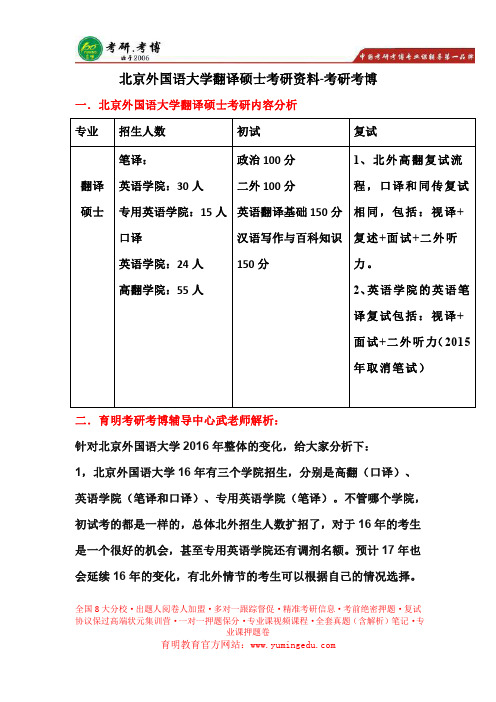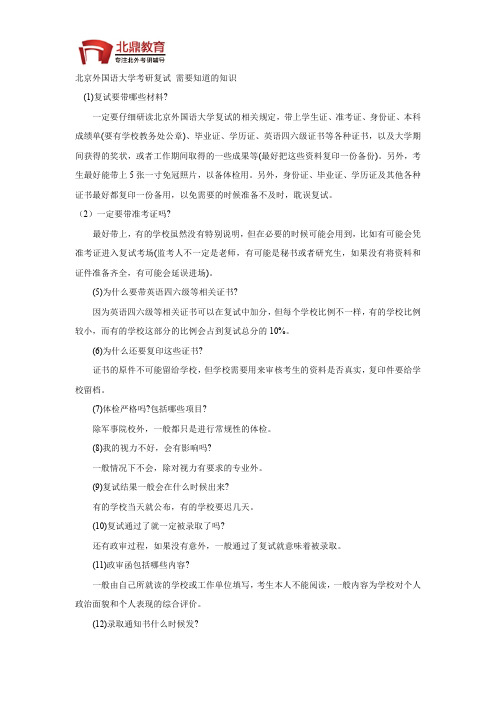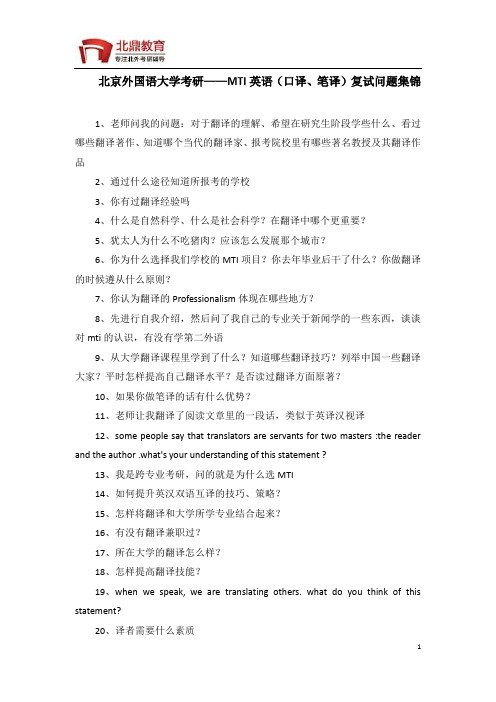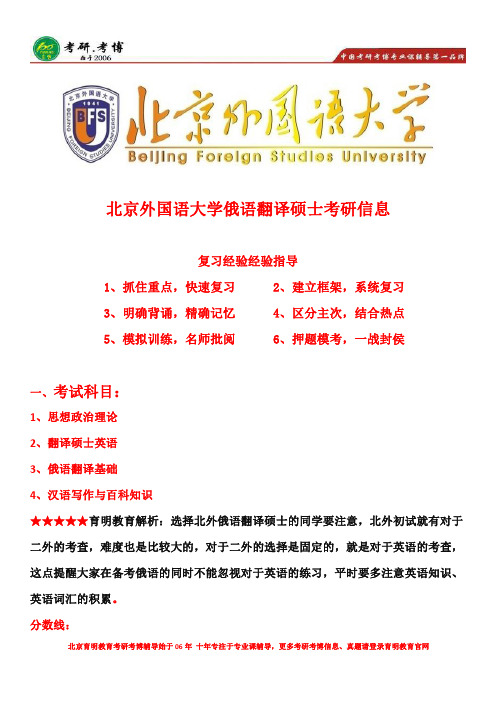【环球时代】北京外国语大学高翻考研复试材料Building excitement(视译)
北外英语学院翻译考研真题

北外英语学院翻译考研真题一、英译汉Passage 1:The Price of EducationThe fact that university education has become such a lucrative business has attracted much attention. Universities in the United States, for example, constantly compete to attract students, and they do so by offering various inducements.Some universities offer better facilities, and try to create an attractive environment in which to live and study. Increasingly, however, the quality of education is also being judged by the percentage of graduates who are able to find employment after graduation. Employers, it seems, are no longer satisfied with a university education per se, but want to be assured that graduates will have the skills necessary for the job. To ensure this, some universities are offering simulated work experience as part of their degree programs. Some universities even venture into the realm of industry and commerce, regarding themselves as training colleges rather than as scholarly institutions.The motives behind this new emphasis on practical training are not entirely altruistic. Many universities in the United Kingdom, for example, rely heavily on government funding. The thinking is that by producing employable graduates, universities are not only ensuring that their graduates get good jobs and earn good money, they are also reducing the burden on thestate. Indeed, in some countries, universities that fail to achieve high levels of graduate employment are actually penalized financially.But what is sacrificed in this obsession with practicality? The traditional concept of a university is based on the belief that knowledge is valuable in itself, and that the purpose of education is the pursuit of truth. To surrender this belief and degrade the university to the role of industry training center is to throw the baby out with the bathwater. Certainly, graduates must be able to find employment to support themselves, but a society that puts material gain above all else is a society that has lost its soul.Passage 2:Another Look at Cross-cultural CommunicationThe common expectation of much cross-cultural training is that it is designed to help business people improve their cross-cultural communication competence, thus increasing performance in a variety of multicultural or international contexts. Cross-cultural training often takes the form of brief seminars, sometimes with hands-on experiential exercises and is meant to be enjoyable, eye-opening and informative. Many authors believe that by offering such training, organizations are doing the right thing for their employees because effective cross-cultural communication skills can be a competitive advantage in business.However, less attention has been given to understanding the linkage between the skills and competencies that have been delineated and measured and the ability of learners to effectively apply such knowledge and abilities in specific situations they are likely to encounter at work. Despite the proliferation of studies advocating the use of cross-cultural training toenhance global management effectiveness, very little is known about how training may affect the actual performance of individuals or groups that are experiencing business or mission/aid-related challenges outside of their native cultural contexts.In today’s globalized and technological world, businesses and individuals are more connected across cultural boundaries than ever. In fact, almost all businesses from small to multinational employ individuals who have some form of cross-cultural interactions on a daily basis. By increasing our understanding of the linkages between knowledge, skills and abilitiesand desired training outcomes, we may be able to help individuals and organizations more effectively navigate the challenges associated with increasingly dynamic and complex cross-cultural task environment in which they operate.二、汉译英翻译 Passage 1:教育的代价大学教育已成为一个利润丰厚的生意,这一事实引起了广泛关注。
北京外国语大学翻译硕士 复试大纲、复试真题

全国8大分校·出题人阅卷人加盟·多对一跟踪督促·精准考研信息·考前绝密押题·复试协议保过高端状元集训营·一对一押题保分·专业课视频课程·全套真题(含解析)笔记·专业课押题卷北京外国语大学翻译硕士考研资料-考研考博一.北京外国语大学翻译硕士考研内容分析专业招生人数初试复试翻译硕士笔译:英语学院:30人专用英语学院:15人口译英语学院:24人高翻学院:55人政治100分二外100分英语翻译基础150分汉语写作与百科知识150分1、北外高翻复试流程,口译和同传复试相同,包括:视译+复述+面试+二外听力。
2、英语学院的英语笔译复试包括:视译+面试+二外听力(2015年取消笔试)二.育明考研考博辅导中心武老师解析:针对北京外国语大学2016年整体的变化,给大家分析下:1,北京外国语大学16年有三个学院招生,分别是高翻(口译)、英语学院(笔译和口译)、专用英语学院(笔译)。
不管哪个学院,初试考的都是一样的,总体北外招生人数扩招了,对于16年的考生是一个很好的机会,甚至专用英语学院还有调剂名额。
预计17年也会延续16年的变化,有北外情节的考生可以根据自己的情况选择。
2,2016年的分数线和以往有所不同,英院笔译217,口译209,高翻学院16年没有专业课划线,总分350,单科过线就可以参加复试,专用英语学院也是和高翻学院一样,总分350.3,三个学院初试一样,只是复试和课程设置不同,从竞争激烈程度来看一次是高翻,英院和专用英语学院。
育明教育考博分校针对北京外国语大学翻译硕士专业考研开设的辅导课程有:专业课一对一·全程集训营·视频班·复试保过班·高端协议班。
每年专业课课程班的平均通过率都在85%以上。
育明学校从2006年开始积累的深厚高校资源,整合利用历届育明优秀学员的成功经验与高分资料,为每一位学员构建考研成功的基础保障。
北京外国语大学高翻学院研究生复试难度解析

北京外国语大学高翻学院研究生复试难度解析“高翻”,顾名思义,就是高级翻译。
既然是培养高级翻译,就会在选材、培养等环节严格遵从高级翻译的标准。
在选材,也就是入学考试,尤其是复试这个环节,这个标准表现为母语级或接近母语级的外语水平、扎实的国文基础、广阔的知识面、深厚的文化底蕴、良好的表达能力、出色的临场应变能力和平稳淡定的心理素质;在培养环节,这个标准则表现为高强度训练和严格的中期考核筛选制度。
以上的这些标准决定了高翻学院的复试是很有难度的,而且这种难度的性质与传统的高级别英文考试截然不同。
翻译是一种实践性很强的学科,你的水平的高低直接表现在嘴上,一开口便见高低。
而传统的考试,包括专八、雅思和GRE等都主要是在笔试上拼输赢。
首先,传统的高级别英文考试大多是一种资格性考试,而高翻入学考试是一种选拔性考试。
其次,传统的考试侧重于笔试,因此对于考试来说有一定的思考时间,即使答错了也还有时间去修改,因此考试结果在交卷之前都是可以改进的。
但高翻复试则是一种即兴发挥。
无论是复述、无笔记交传,还是即兴演讲,都是要在瞬间一边完成的,中间绝少有思考时间,答案一出口便难以修改,而且一旦修改就会影响整体效果。
同时,严肃的考场氛围和严格而挑剔的考官也会给考生的心理造成极强的现场压力。
如果心理素质稍微脆弱一点,都会对考试结果造成极大影响。
再次,传统的考试很多只需通过突击学习便可通过的,即使需要积累,积累的时间也不需要很长。
而高翻的复试考试则纯粹是一种厚积薄发。
你古文学得很好,也很爱读其他自然文史著作,聆听名家的讲座,热爱思考问题,对外界事物或问题往往能提出自己独特的观点……所有的这一切,实际上都是一种积累,而这些积累就会在你参加高翻复试的时候表现出来。
所以,不要只把没考上高翻单纯归咎于准备时间短、外语能力不强等因素,真正的原因不是你能不能考上高翻,而是这些前期的积累决定了你适不适合考高翻。
最后,也是最重要的一点,高翻复试的难度是相对的。
北京外国语大学09年、10年高翻经验贴

北外2009、2010年考研经验贴1..潜水这么久,感谢星光上的前辈。
我也为星光做点贡献,说说今年高翻的复试~~~客观记录过程,不带任何个人色彩,至于大家表现,希望大家积极参与啦。
早上视译复试分8点和8点30两批,每批两组,每组30人。
本人分到8点组,时间很是早,晚上一定要睡好!视译四小段,一张纸,五分钟准备,有些仓促。
开始翻译。
文章大意是讲发展观念的转变吧。
而后复述,两遍共8分多一点,桌上有3张草纸,听后复述。
讲negotiation的,题材有些出乎意料。
面试有上午组,下午组,本人恰巧为下午其中一组的第一个,1点20被叫,进去一篇文章,今年后面没有问题。
8分钟做笔记。
抽到了一个我很无奈的文章,讲avantar,我想了半天才知道是阿凡达,没看过!第一个问题:the main idea of the article第二个问题:what's reason for people to see the movie?第三个问题:have you seen it? (我诚实地说没有,说不喜欢看这类的,喜欢看the reader那种的)第四个问题:what impress you most in the reader?第五个问题:文章中提到科学怪人会看,你觉得不爱科学的会看吗?(自己是这么理解的)第六个问题:这个问题比较长,大意是说有人说science fiction在中国不像西方流行,因为中国special,你怎么看?整个面试下来感觉自己很无厘头,平时自己没准备这么家常的话题。
不过确实有同学抽到汇率等热点了,真不知道自己是幸运还是不幸啊!其实不用紧张,就是随便聊聊,看看就后两个问题还像个问题,呵呵,虽然答得也不怎么的吧。
但是老师很和蔼,一直在笑,可能笑我傻吧。
具体细节经验有机会再做补充吧!自我整体感觉不怎么样,不过尽力就好!大家都加油啦!2010高翻经验贴高翻这个最热的专业今年还米有经验贴,偶从06年考北外本科起就成为了星光老牌潜水运动员,基本是被雷姐,飞仙们“拉扯大”的。
北外高翻考研经验(通用3篇)

北外高翻考研经验(通用3篇)北外高翻考研经验篇1今年北外复试于3月30号结束,之前一直在等复试结果,查到复试成绩,知道拟录取后激动得难以入睡,毕竟自己实现了当初的誓言,如愿被北外高翻录取。
4月3号晚,霸气的北外终于提前公布录取结果了。
也许各位会担心复试的各种黑幕,但是我想说:北外很公平,唯才是举。
我本科是安徽一所普通一本,当时复试的有好多985、211的,像川大、厦大、中传、复旦、同济,但是最后我录取了。
高翻的复试比例是1:2,所以本科不好不要紧,关键是实力。
北外的MTI不同于其他学校,因为要考二外,初试要考三门语言:英、汉和第二外语。
我的考研准备时间是Mar.20xx—Dec.20xx,但完全投入是July1st—Dec.24th,头尾六个月吧。
初试总分405:英语翻译基础128,汉语百科知识与写作122,翻译硕士德语83,政治72复试面试:75.3,总成绩:77.71,录取结果:拟录取。
考研一路走来得到很多帮助,刚开始也是读着经验贴过来的,深知考研不易,现在写写自己的备考经验,希望为20xx年考研同学们助一臂之力。
一、初试A.专业课英语翻译基础:一直以来都钟情于翻译,所以练习从未断过。
之前有考中口和二笔,中口难度适中,二笔难度较大,建议从三笔考起。
感兴趣也可考BEC,高口笔试也不难,反正与考MTI并行不悖。
考北外高翻的都知道专业课才是重点,进复试各科都有一定要求,且以专业课总分排名,所以一定要把专业课学好。
我去年暑假前都在准备二笔,看了不少也练了不少译界权威书籍,从暑假开始更是加强练习,每天至少两篇。
七月练英译汉,八月汉译英。
想强调一点,翻译练习务必动笔写下,不能总抱着欣赏译文的态度来学翻译,实践才能出真知。
我当时都是先读原文再翻译,之后对照译文找出差距,看看自己是措辞不当还是理解不到位,一些好的表达就记下来。
我个人备有四个翻译练习本,两个已完全写满,笔记就写在自己的译文下方,还有一些练习心得,不时拿出来翻翻。
北外复试必知十三问

北京外国语大学考研复试需要知道的知识(1)复试要带哪些材料?一定要仔细研读北京外国语大学复试的相关规定,带上学生证、准考证、身份证、本科成绩单(要有学校教务处公章)、毕业证、学历证、英语四六级证书等各种证书,以及大学期间获得的奖状,或者工作期间取得的一些成果等(最好把这些资料复印一份备份)。
另外,考生最好能带上5张一寸免冠照片,以备体检用。
另外,身份证、毕业证、学历证及其他各种证书最好都复印一份备用,以免需要的时候准备不及时,耽误复试。
(2)一定要带准考证吗?最好带上,有的学校虽然没有特别说明,但在必要的时候可能会用到,比如有可能会凭准考证进入复试考场(监考人不一定是老师,有可能是秘书或者研究生,如果没有将资料和证件准备齐全,有可能会延误进场)。
(5)为什么要带英语四六级等相关证书?因为英语四六级等相关证书可以在复试中加分,但每个学校比例不一样,有的学校比例较小,而有的学校这部分的比例会占到复试总分的10%。
(6)为什么还要复印这些证书?证书的原件不可能留给学校,但学校需要用来审核考生的资料是否真实,复印件要给学校留档。
(7)体检严格吗?包括哪些项目?除军事院校外,一般都只是进行常规性的体检。
(8)我的视力不好,会有影响吗?一般情况下不会,除对视力有要求的专业外。
(9)复试结果一般会在什么时候出来?有的学校当天就公布,有的学校要迟几天。
(10)复试通过了就一定被录取了吗?还有政审过程,如果没有意外,一般通过了复试就意味着被录取。
(11)政审函包括哪些内容?一般由自己所就读的学校或工作单位填写,考生本人不能阅读,一般内容为学校对个人政治面貌和个人表现的综合评价。
(12)录取通知书什么时候发?5月中旬到7月初。
(13)复试时会不会遇到“潜规则”?不排除发生这种情况的可能性,但这毕竟是极少数,而导师更多关心的其实还是学生的成绩和综合素质,所以这个问题不应是考生最关心的问题,考生所要做的就是在复试前努力提升自己的综合实力。
北京外国语大学高翻英汉同传考研备考资料 英译汉练习题

北京外国语大学高翻英汉同传考研备考资料英译汉练习题1.将下列段落译为汉语In the pre-modern era,political,economic,and social life was governed by a dense web of interlocking relationships inherited from the past and sanctified by region.Limited personal freedom and material benefits exited alongside a mostly unquestioned social solidarity.Traditional local orders began to erode with the rise of capitalism in the eighteenth and nineteenth centuries, as the increasing prevalence and dominance of market relationships broke down existing hierarchies.The shift produced economic and social dynamism,an increase in material benefits and personal freedoms and a decreasing in communal feeling.As this process continued,the first modern political ideology,classical liberalism,emerged to celebrate and justify.Liberalism stressed the importance of the rule of law,limited government,and free commercial transactions.It highlighted the manifold rewards of moving to a world dominated by markets rather than traditional communities,a shift the economic historian Karl Polanyi would call“the great transformation.”But along with the gains came losses as well-of a sense of place of social and psychologycal stability,of traditional bulwarks against life’s vieissitudes.Left to itself,capitalism produced long-term aggregate benefits along with great volatility and inequality.This is combination resulted in what Polanyi called a“double movement”a progressive expansion of both market society and reactions against it.1.将下列短文译为汉语The European Union was established with a legal treaty and is feounded on the principle of the rule of law.This concept centers on a set of rules governing all socity’s processes and interactions and being above all society’s institutions and organizations.The rules or laws set the moral and ethical standards by which the behaviour of members of society and organizations are judged.For the rule of law and thereby civil society to flourish,it requires the citizens of a country to respect and trust legal processes,and the law to be applied in a consistent way to all.This gives people a feeling of inclusiveness and optimism about their future.The European Union’s Governance for Equitable Development(GED)project,implemented by the United Nations Development Programme(UNDP)from2007to2012,has assisted China to benefit from knowledge of Europe’s developed legal system and civil society through technical exchange, research and knowledge sharing.As people’s incomes grow and material living standards rise,their expectation about the quality of life,participation in civil society,protection of property and individual rights increase. Meeting these expectation for a better life in a rapidly urbanizing society with a still significant rural population is one of the key challenges facing China today.This is where the GED project has supported China in moving to a more equitable,inclusive and vibrant civil society,based on the rule of law.The project has worked with three key Chinese agencies,the National Peoples’Congress,the Supreme People’s Court and the Ministry of Civil Affairs on topics ranging from law drafting and court efficiency to registration of civil society organizations.The project has produced remarkable results over five years,leading to an improved environment for civil society to flourish in China, increased citizen participation in law marking,reduced barriers to seeking justice,increased transparency and efficiency of selected courts and progress in the consistency of court decisions.。
北京外国语大学考研——MTI英语(口译、笔译)复试问题集锦

北京外国语大学考研——MTI英语(口译、笔译)复试问题集锦1、老师问我的问题:对于翻译的理解、希望在研究生阶段学些什么、看过哪些翻译著作、知道哪个当代的翻译家、报考院校里有哪些著名教授及其翻译作品2、通过什么途径知道所报考的学校3、你有过翻译经验吗4、什么是自然科学、什么是社会科学?在翻译中哪个更重要?5、犹太人为什么不吃猪肉?应该怎么发展那个城市?6、你为什么选择我们学校的MTI项目?你去年毕业后干了什么?你做翻译的时候遵从什么原则?7、你认为翻译的Professionalism体现在哪些地方?8、先进行自我介绍,然后问了我自己的专业关于新闻学的一些东西,谈谈对mti的认识,有没有学第二外语9、从大学翻译课程里学到了什么?知道哪些翻译技巧?列举中国一些翻译大家?平时怎样提高自己翻译水平?是否读过翻译方面原著?10、如果你做笔译的话有什么优势?11、老师让我翻译了阅读文章里的一段话,类似于英译汉视译12、some people say that translators are servants for two masters :the reader and the author .what's your understanding of this statement ?13、我是跨专业考研,问的就是为什么选MTI14、如何提升英汉双语互译的技巧、策略?15、怎样将翻译和大学所学专业结合起来?16、有没有翻译兼职过?17、所在大学的翻译怎么样?18、怎样提高翻译技能?19、when we speak, we are translating others. what do you think of this statement?20、译者需要什么素质21、翻译的本质是什么22、你最喜欢的翻译家是谁,介绍一下他的作品23、口译和笔译的区别是什么24、做一名译者,你有何优势。
北京外国语大学考研―高翻学院英语MTI备考经验(精)

北京外国语大学考研—高翻学院英语 MTI 备考经验考研是一个长期的过程, 尤其是对于二战的同学来说, 尤其磨练心智。
因此, 保持一个良好、稳定的心态是取得胜利的大前提。
一、初试:四门科目为基英、互译、二外和政治。
1. 基础英语基础英语的题型包括:改错、阅读、判断正误、 gap filling 和翻译。
可见考的都是大家的基本功,在于长时期的积累,因此最好每天都保证一定的练习。
改错可以用专八的真题来练练, 量不在多, 我每天就练一到两篇, 做完总结一下每道题考的语法点是什么、自己错在哪里, 我认为这样慢慢积累就会形成一定的感觉。
阅读我觉得大家可以把历年的真题反复多做几遍, 琢磨琢磨老师的出题风格和思路,然后自己再根据需要适当找一些题来做。
我自己是用星火的报刊阅读, 上面的文章涵盖的话题比较广, 我认为还比较适合练习。
也有研友用专八、托福雅思或考研英语阅读练习的, 都是可以的。
个人认为高翻的阅读题出题思路还有所不同, 所以最重要的还是练真题, 自己再找题也就是练练手感, 保持做题的速度了。
Gap filling 的练习除了真题以外,有同学给我推荐了《张剑考研英语黄皮书2014考研英语阅读理解 Part B高分突破(新题型 40篇》 ,里面有一个版块就是 gap filling,比较适合练习用。
基英的翻译比较偏文学, 我买了张培基散文 108篇, 虽然每翻完一篇对照张老师的译文都会觉得很受挫, 但还是慢慢会有进步的。
毕竟好的翻译功底不是一朝一夕就能练就的。
2. 英汉互译大家应该都了解, 英汉互译中英各两段, 一长一短。
中翻英有一段是政府公文, 找政府的各种报告参考参考还是比较好把握的。
另外李长栓老师的《非文学翻译》和平卡姆的《中式英文之鉴》一定要多看看,按照上面的要求来练习。
小品文就比较口语化了, 我在准备的时候觉得十分头疼。
能找到的资料很有限, 并且翻完没有参考译文也觉得心里没底, 没办法提高。
英译汉除了真题以外, 我还按照前辈们的指点,在 Eco 论坛上找了一些经济学人上的文章来练习,另外 FT 上面有双语阅读的文章, 也是不错的练习材料。
北京外国语大学高翻复试资料 英汉同声传译技巧

北京外国语大学高翻复试资料英汉同声传译技巧一、谓语动词的处理英语谓语动词一般不会构成同传的障碍,但特定类型的谓语如果处理得当,可以帮助搭好句子框架,减少接续困难,提高同传效率,减轻大脑负担。
不少情况下,英语谓语由动词加名词构成,表示一个动词的意思,这时,我们可以将其译为动词,我们称之为词类转换。
词类转换在同传中是必不可少手段。
例如:My delegation will show flexibility in the consultations on the program of work.可以转换词类,译为“我国代表团将灵活地磋商工作计划”。
采取这种译法,则可以紧跟原文顺序,作到几乎与原文同步结束,为下一句争取了宝贵的时间。
从这个意义上讲,词类转换对同传更为重要英语被动语态谓语的处理也是同传的难点之一。
被动句在同传中可以变为主动句译,但同传时为了达到顺译的目的,还可以采取其它一些变通方法,比如将谓语动词和主语合并译为名词短语作汉语主语:The economic freedom was provided by breaking up large concentration of power.经济自由的获得是因为打破了高度集中的权力。
二、定语的处理方法除单词和较短的片语外,英语的定语通常在后,汉语一般在前。
将英语的后置定语译为中文时理应调整语序,使之符合汉语表达习惯。
同声传译时由于无法预见定语,已经将定语之前的部分先行译出;或者知道有定语,但定语过长,译完定语再译中心词有可能将中心词忘掉,这时,就需要通过灵活变通的办法,在不对原文语序作重大调整的情况下,将定语在中心词之后译出。
综合起来,可以应用以下几种手段:1、独立成句This has been a major engine of economic growth comparable to the earlier experiences in South East Asian neighboring countries.这大大带动了经济增长,类似于东南亚各国早期的发展历程。
北外高翻学院同传考试试题解析[1]1
![北外高翻学院同传考试试题解析[1]1](https://img.taocdn.com/s3/m/bf5c5a1cb7360b4c2e3f64a8.png)
2005年研究生招生基础英语试题参考译文(“王阳明捉贼”部分)北京外国语大学高级翻译学院李长栓原文:明代哲学家王阳明早年被贬到贵州龙场做地方官时,捕获了当地一个强盗头目。
该头目在受审时说:“我犯的是死罪,要杀要剐,任你怎么处置,只请你不要和我谈道德良知。
像我这种人是从来不谈这个的,甚至连想都没有想过。
”王阳明说:“好的。
今天我不和你谈道德良知。
不过,天气这么热,你看在审案前我们还是把外衣脱了吧。
”强盗头目说:“好!”脱去外衣后,王阳明又说:“还是热,再把内衣也脱了吧。
”强盗头目当然不会在乎赤膊,于是就脱去内衣。
庭上庭下两人身上只剩下一件裤头。
而此时王阳明更进一步,说道:“干脆我们把裤头也脱了吧,全身赤裸更自在……”一听说连裤头也要脱,强盗头目赶紧说:“这可使不得!这可使不得!”面对此情此景,王阳明当即来了一番水到渠成的因势利导:“为什么…使不得‟,这是因为在你心中还剩有那么一点羞耻感。
可见就是像你这样十恶不赦的家伙,我照样可以和你谈…道德良知‟……”强盗头目心服口服,随即讲自己的种种罪行一一如实供出。
参考译文:The ancient philosopher Wang Yangming offended some powerful officials of the imperial court and was demoted to the position of a local official in the remote province of Guizhou. During his term, he arrested the head of a burglary gang. In the trial, the suspect said, "I have committed a death penalty crime. You can kill me or torture me all you want but spare me the moral talk. A guy like me never talks morals. I don't even think about them."Wang replied, "OK, I won't talk morals with you today but since it's hot, I suggest we take off our coats before the trial.""OK," said the suspect, and took his coat off."It's still too hot, perhaps we should take off our shirts too," said Wang.The gangster naturally didn‟t mind being bare-chested, so he took off his shirt. Now both of them had nothing left but their pants. Wang then said, "What about the pants? We‟ll be more comfortable if we‟re naked.""No way! No way!" protested the suspect.At this point, Wang cut to his point and said, "The reason why you wouldn't take off your pants is that you still know shame. This proves that even a notorious and ruthless manlike yourself is concerned with morality. "The suspect was so impressed by Wang's argument that he confessed all his crimes.2009年研究生入学试题参考译文和分析(“国庆节返乡”部分)/李长栓星期三, 05/06/2009 - 07:57 —李长栓《国庆节回家》翻译中的主要问题北京外国语大学高级翻译学院李长栓理解问题汉语中充满了歧义。
北京外国语大学高翻学院考研专业介绍、报录比、题型、参考书目、备考

北京外国语大学高翻学院考研专业介绍1.院系介绍北京外国语大学高级翻译学院成立于1994年,是北外的王牌专业之一,其前身为1979年设立的联合国译员训练班(部)。
截至2016年,高翻学院已为联合国系统和国内机构共培养了1200余名专业翻译人才。
高翻学院毕业生的主要就业方向包括:国家部委、事业单位,例如外交部、商务部;大型国企;高校老师和自由译者等。
2.招生考试概况高翻学院招收的硕士专业有三个:英汉同声传译(MA):属于学术型学位,两年制,招生人数在30人左右,建议基础扎实、口语优秀的英语专业同学选择。
考试科目为:政治、二外(可选俄法德日西)、英语基础测试(技能)、英汉互译(同传)。
英语口译翻译硕士(MTI):属于专业型学位,两年制,所授课程与MA一样,招生人数在60人左右,建议基础扎实、口语较好的英语专业和基础较好的跨考专业的学生选择。
考试科目为:政治(可选俄法德日西)、二外、英语翻译基础、汉语写作与百科知识。
复语同传:属于学术型学位,两年制,招生人数在15人左右,学习英语和小语种口译,建议小语种专业的学生选择。
涉及的语种包括:俄法德西等。
考试科目为:政治、二外英语、对应小语种基础、英汉互译(复语)。
以上科目中,除了政治之外均使用北外自主命题试卷,欢迎前来获取历年真题、答案以及复习策略等资料。
3.高翻学院报名录取情况高翻学院因其实力强劲、就业形势好,一直是北外竞争最激烈的院系之一,尤其是英汉同声传译专业,一直保持着5%左右的报录比。
另外值得注意的是,高翻学院的复试比例为201120122013报考人数录取人数报录比报考人数录取人数报录比报考人数录取人数报录比英汉同声传译1249635%1170424%1031424%俄英汉同声传译26312%27311%16213%法英汉同声传译1915%19421%10330%德英汉同声传译25520%20315%22314%西英汉同声传译10440%10110%5240%韩英汉同声传译2015%28311%17212%泰英汉同声传译3133%翻译硕士(MTI584679%875159%1215949%英语口译)注:北外从2014年起不再公布报名录取人数比,以上数据仅供参考;实际每年招生专业可能会有变动,以官方公布的招生专业列表为准政治略。
北外高翻中英同声传译初试复试经验

北外高翻中英同声传译初试复试经验先自我介绍一下吧,本科非英专。
英语四六级600+,专四优秀,没有CATTI证书。
今年MA的招生名额减少了一半,统招只有9个名额,竞争更加激烈了。
我选择考MA 是因为我更喜欢MA的考试科目,觉得比起汉语写作和背百科词条,自己更擅长做英语题目。
但在看到招生简章的时候还是有种晴天霹雳的感觉。
各位学弟学妹在选择专业的时候,一定要结合自己的情况多方面考虑。
进入正题吧。
一、政治北外对政治的要求是过国家线即可,也就是55分左右,所以按部就班复习就可以,不必过分担心。
我在八月的时候过了一遍2017年的考研政治大纲。
但是这一周的课下来对大部分人来说大概只能留个印象,对我来说几乎是一点印象都没留下,就是了解了一下政治的考试内容。
在加上每年的大纲都会有或多或少的变动,在开完十九大之后我相信19年的大纲变动会更多,所以我的建议是等到九月新一年的考试大纲出来之后再开始复习。
我的第一轮复习方法是看一章节大纲的内容,做肖秀荣《命题人1000题》相应的题目,只做选择题,认真看解析。
我也有买肖秀荣的《精讲精练》,但是因为这本书出在大纲出来之前,有些内容可能是旧的,所以我还是根据大纲复习。
第一轮复习大概要花一个月时间。
我的第二轮复习就到了十一月了,这段时间主要是做历年真题。
我做完了选择题,主观题没有时间做,但是也会思考一下,写一下思路。
我觉得有必要自己尝试写完整的主观题答案,因为想跟实际写出来是不一样的。
在这段时间我还买了肖秀荣的《考点预测背诵版》和《形势与政策》,前者感觉作用不是特别大,后者还是要看一看的。
更新的时事,直到12月发生的事情都是有可能考的。
最后,十一月底到考试前,我买了《肖八》、《肖四》,选择题都做了几次,主观题的答案都自己整理了一遍,背诵。
有很多人说肖教授的主观题答案很难背,我就把这些题目和答案自己整理了一下,自己组织语言,最后整理出三万多字的文档,打印出来背了几天。
政治大概就是这样,不必花更多的时间了,也没必要看太多的材料,找准适合的背就是了。
北外高翻英语口译、英汉同传复试分数线、报录比和复试建议

350
政 治 55 199
英语 55
英汉同传:
年份
报考人数 录取人数 考录比 复试总分 单 科 线 专业科目
线
(政治、 总分线
外语)
2011
1249
63
5%
355
55
216
2012
1170
42
4%
345
52
224,每门
专业课线
112
2013
1031
42
4%
350
54
204,每门
专业课线
102
2014
350
政 治 55 216,每门
英语 55 专业课线
108
二、高翻学院复试建议
北外高翻的复试没有笔试,北外高翻的复试分为三部分:视译,复述和面试。北外高翻
复试视译和复述重点考察的是考生的听力及外语的语言表达能力 ,面试常常会涉及经济、
政治、环境等领域,有时有事实或简单的自然科学的内容。
针对视译,大家在掌握了完善的视译技巧之后,要找材料来做大量的练习,在复试之前 要坚持练习,直到复试。 如果对于视译技巧并不熟悉,或者没有经过相应的训练和培训, 建议参加复试辅导课程,以免将错误的方法越练越熟,影响复试成绩。
【学霸分享】—北京外国语大学俄语MTI考研复试、考研真题解析、考研笔记分享

北京外国语大学俄语翻译硕士考研信息复习经验经验指导1、抓住重点,快速复习2、建立框架,系统复习3、明确背诵,精确记忆4、区分主次,结合热点5、模拟训练,名师批阅6、押题模考,一战封侯一、考试科目:1、思想政治理论2、翻译硕士英语3、俄语翻译基础4、汉语写作与百科知识★★★★★育明教育解析:选择北外俄语翻译硕士的同学要注意,北外初试就有对于二外的考查,难度也是比较大的,对于二外的选择是固定的,就是对于英语的考查,这点提醒大家在备考俄语的同时不能忽视对于英语的练习,平时要多注意英语知识、英语词汇的积累。
分数线:2016年思想政治理论、翻译硕士英语单科分数是53分两门专业课(俄语翻译基础、汉语写作与百科知识)215分总分350分2015年思想政治理论、翻译硕士英语单科分数是52分两门专业课(俄语翻译基础、汉语写作与百科知识)200分总分345分2014年思想政治理论、翻译硕士英语单科分数是55分两门专业课(俄语翻译基础、汉语写作与百科知识)221分总分350分★★★★育明教育解析:从分数线上看,北外俄语翻译硕士对于思想政治理论和翻译硕士英语的要求相对比较稳定,过线就可以,但是同学们尽量把分数提高,在总分上占有优势,两门专业课北外有单独的划线,这几年的分数线基本在200——220分左右,从这看出北外对于专业课是十分看重的,同学们一定要认真准备,认真的对待,这也是拉开距离的地方.参考书:翻译硕士英语:《新编大学英语》(1-5册),浙江大学编著,外语教学与研究出版社《新编大学英语语法》黄建滨,邵永真,外语教学与研究出版社俄语翻译基础蔡毅等编:《俄译汉教程(增修本)》上册,外语教学与研究出版社,2006年。
2、周允、王承时编:《汉译俄教程》,外语教学与研究出版社,1981年。3、吴克礼主编:《俄苏翻译理论流派述评》(下编),上海外语教育出版社,2006年。汉语写作与百科知识《汉语写作与百科知识》(李国正)《翻译硕士真题汇编》+《翻译硕士考研手册》育明教育《中国文化读本》(叶朗)《应用文写作(第四版)》(夏晓鸣)《高考满分作文》育明教育解析:第一本太厚了,要学会开始挑重点看,也就是看上去比较符合北外出题风格的知识点。
【环球时代】北京外国语大学高翻考研复试材料Building excitement(视译)

Building excitementCan China avoid a bubble?THE property market illustrates the growing divergence between rich-world and emerging economies. In most developed countries (with a few exceptions, such as Australia and Canada) governments are trying to breathe life into property. In developing ones they are trying to cool things down. In the West the question is when prices will stop falling. In the East it is whether they will stop rising.For many institutional investors, emerging markets, however buoyant, are not worth taking big bets on. Thanks to the bust, the rich world offers high-quality properties in liquid markets at lowish prices. The developing countries are a riskier development prospect, with new homes, offices and malls being built at speed to cope with fast-rising demand.That demand is undoubtedly enormous. Brazil is thought to be short of some 8m homes; the whole of India has fewer hotel rooms than Las Vegas; in Saudi Arabia a long-awaited mortgage law is expected to kickstart a residential boom. Yet the pitfalls are also cavernous. Legal issues are one source of uncertainty. Investors complain that China’s system is capricious, for instance. “China will be one of the biggest property markets in the world in five years’ time,” says one b ig fund manager. “But if you put millions into a building in China and sell it, it is not clear that you will be able to take your money out.” Retail lenders express similar misgivings about the process for repossessing homes in developing markets.The biggest worry of all is the rush of new supply. The pace of development is often frantic, nowhere more so than in China. According to Barclays Capital, more than 40% of the skyscrapers due for completion in the next six years will be in China, increasing the number of tall buildings in Chinese cities by more than half. Landscapes are changing in a matter of days. One of the more hypnotic items on YouTube is a time-lapse video of a 15-storey prefabricated hotel in Changsha being put up in just six days. “The range of outcomes in London and New York is pretty limited,” says one investor. “In Shenzhen you can be building a block of apartments with four others going up alongside.”One way to manage the risk of oversupply is to take capital out of emerging markets as quickly as possible. ING’s real-estate asset-management arm (soon to be part of CBRE) works with local firms to build flats and homes for sale in markets such as China, enabling it to realise profits in two or three years. Another is to go for the less crowded parts of the market. Mr White of CBRE thinks that the logistics sector is one of the more promising avenues for foreign investors, in part because the market is dominated by a handful of global firms based in America. Shopping centres are another area where foreigners still have an edge over locals.But many investors who have raised funds for deployment in emerging markets will have trouble finding a home for their money. One reason is that these markets are thin: there is very little buying and selling of existing properties. Another is competition from locals. Mainland Chinese developers are wildly optimistic because they have seen values rise, says David Ellis of MayerBrown JSM, a law firm. “They are using a different spreadsheet.”All this helps explain why many people are nervous about the state of the Chinese property market in general, and the residential part of it in particular. High-profile hedge-fund managers such as Jim Chanos give warning (self-servingly) of a property crash even wo rse than Dubai’s. In January three of the ten biggest short positions in Hong Kong-listed mainland companies were held in property firms. Nationally, incomes in China have largely kept pace with rising prices (see chart 7), but an IMF report in December sa id that in some big cities prices “appear to be increasingly disconnected from fundamentals”.Rationing the air supplyThe Chinese government has unveiled a series of measures since April 2010 to mute house-price inflation. They include raising the minimum downpayment for first-time buyers to 30% of a home’s value, up from 20% before, and a stop on mortgages for people buying a third or subsequent home. These measures have had some success. The year-on-year price rise has slowed down: in December it was 6.4%, not that much higher than the overall inflation rate.Even so, the market continues to look extremely buoyant on many measures. Total property loans outstanding last year rose by 27.5%, which at least was slower than in 2009. Policymakers lean towards further tightening. A property tax was announced in Shanghai and Chongqing at the start of this year, causing a rush to seal deals before it takes effect. Transactions in Shanghai in the first half of January reportedly jumped by more than a third year-on-year, according to local estate agents. Wen Jiabao, China’s prime minister, has said he wants to see the residential market return to a “reasonable level” before his term of office ends in 2013.As well as dampening down demand, the Chinese have been trying to increase supply. That may seem counterintuitive in a country with a home-ownership rate of about 80%. But that startlingly high rate was the result of a huge, one-off transfer of government housing to private ownership in the late 1990s. Much of i t is dilapidated and most people want to move out and up. “There is pent-up demand that has been building for 50 years,” says Michael Klibaner of JLL in Shanghai.The problem for the average buyer is that prices have been driven higher not just by other would-be homeowners but by a complex chain of speculative activities that reaches right back to another arm of China’s government, the local authorities. Land sales are a big source of revenue for local governments, and by drafting development plans for the land the government can hike its value several times over.Until recently, local governments would sell this land to developers for very little upfront. A firm could buy land worth 5 billion yuan with just 500m yuan ($75.9m) in working capital, says Jinsong Du of Credit Suisse. Even better, the developer could then offer that land as collateral for a loan of, say, 2.5 billion yuan from a bank. And instead of ploughing those borrowed billions into developing the site, they could use it to buy more land. Developers were not too worried about generating cash flow, because in a pinch they assumed they could always sell the land at a profitor flog as-yet-unbuilt flats to eager buyers on the back of blueprints alone.The viability of this model depends on ever-growing demand, which often comes from speculative investors looking for a chance of quick capital gains. Some are wealthy private individuals; many are enterprises that have been diverting money from capital investment, hoping for juicier returns from property.All of this is a big headache for the central government, which is aiming to keep property affordable for the masses. A huge social-housing programme will eventually bring lots of cheaper housing on stream. In the meantime the government is trying to draw the air out of the speculative part of the market (by restricting mortgages taken out for investment purposes, and by banning many state-owned enterprises from buying land) and to put developers under pressure to build and release properties quickly. Banks now have to put money into an escrow account instead of lending directly to developers. The cash is paid out when construction reaches certain milestones. Downpayments from developers to local governments have shot up, too, and now total 60-70% of the land’s value. That stretches developers’ balance-sheets, encouraging them to drop prices.Carpeted landingThe slowdown in property-price rises suggests that these policies are having some effect. But the upward pressure is still immense. To get round the new rules, some mainland developers are reportedly borrowing money offshore and dressing it up as equity when it comes onshore. The restrictions are not always properly implemented, particularly in smaller cities. A 2009 law allowed mainland insurers to invest another wall of money in property for the first time. Individual savers keep an enormous amount of cash in low-yielding bank deposits and have relatively few investment options, which increases the appeal of property—as does rising inflation.Nonetheless, in two critical respects, comparisons between China and places such as Dubai are misplaced. One is underlying growth in demand. Some places in China may well be getting ahead of themselves: for example, it is not clear whether so many industrial cities really need a brand new central business district. If prices were to turn, the amount of vacant property being held as investment would make a wave of forced selling more likely. But China, with urbanisation and income growth on a massive scale, is clearly different from Dubai’s model of “build it and they will come.”There are better parallels in the Middle East. Emile Habib of GulfRelated, a property-development joint venture in the region, says Dubai is saturated and the best prospects are places with lots of internal demand like Saudi Arabia.The second difference is the amount of leverage in the system. The IMF reckons that loans to developers and mortgages accounted for under 20% of total outstanding loans in late 2009, compared with 52% in Hong Kong and 57% in America. Again, nobody should draw too much comfort from this. In a cash-driven market, liquidity can flow out of the sector quickly; mortgage debt is rising fast from a low base; and a property bust could spill over into other fields to whichbanks have lots of exposure. But as Western policymakers would now wearily agree, less debt means less systemic risk for the banks if and when the property cycle turns.。
2019年北京外国语大学高翻学院翻译学考研经验分享

二、强大的应试阅读能力。如果你对自己的应试能力有信心,在各种标准 化考试中成绩突出,也可以考虑报考 MA。
我建议大家不要闭门造车,一定要把自己的译文拿给别人看,打破自我保 护的屏障。最好的选择是报网上带批改服务的翻译班,具体哪个班我就不 推荐了,只要是接受过系统翻译训练的人(翻译教师、翻译资深从业者、 优秀院校的 MTI 在读学生)应该都能轻松找出考研学生的译文毛病。
第三,扩大词汇量。这里所说的扩大词汇量,不是让大家去死磕单词书, 而是通过科学的方法,比如学习构词法,达到触类旁通、举一反三的效果。 同时,也要注意到平时常用的单词的一些不常用的词义。 第四,多关注时事,尤其是和翻译相关的时事。这一点比较明显地体现在 作文上。通过上面列出的真题,我们发现,很多学校最后的作文题都涉及 到了机器翻译的话题,而这正是当下一直被广泛探讨的问题。如果平时就 有关注和积累这方面的素材,那么发挥起来也是游刃有余的。
01 抓住必要扣分点 既然“翻错了就一定会丢分”,那首先当然得明确什么叫做“翻错了”。 从李长栓老师给出的改卷范例来看,我认为研究生入学考试中的英译汉, 在你的汉语能达到成年汉语母语使用者平均水平的前提下,对你的考察只 会停留在: 一、能否准确理解原文(英语水平); 二、是否具有基本背景知识(常识水平)。 因此,无论你是归化还是异化,大幅调整语序还是遵照原文逻辑,这些都 不是必要扣分点,而既然不是必须扣分,阅卷人为照顾公平就不会轻易扣 分。所以在翻译的时候,也就不用过多去纠结这些风格上的问题,抓住要 害,不要为细枝末节分心。 02 “快狠准”而非“精雕细琢”
- 1、下载文档前请自行甄别文档内容的完整性,平台不提供额外的编辑、内容补充、找答案等附加服务。
- 2、"仅部分预览"的文档,不可在线预览部分如存在完整性等问题,可反馈申请退款(可完整预览的文档不适用该条件!)。
- 3、如文档侵犯您的权益,请联系客服反馈,我们会尽快为您处理(人工客服工作时间:9:00-18:30)。
Building excitementCan China avoid a bubble?THE property market illustrates the growing divergence between rich-world and emerging economies. In most developed countries (with a few exceptions, such as Australia and Canada) governments are trying to breathe life into property. In developing ones they are trying to cool things down. In the West the question is when prices will stop falling. In the East it is whether they will stop rising.For many institutional investors, emerging markets, however buoyant, are not worth taking big bets on. Thanks to the bust, the rich world offers high-quality properties in liquid markets at lowish prices. The developing countries are a riskier development prospect, with new homes, offices and malls being built at speed to cope with fast-rising demand.That demand is undoubtedly enormous. Brazil is thought to be short of some 8m homes; the whole of India has fewer hotel rooms than Las Vegas; in Saudi Arabia a long-awaited mortgage law is expected to kickstart a residential boom. Yet the pitfalls are also cavernous. Legal issues are one source of uncertainty. Investors complain that China’s system is capricious, for instance. “China will be one of the biggest property markets in the world in five years’ time,” says one b ig fund manager. “But if you put millions into a building in China and sell it, it is not clear that you will be able to take your money out.” Retail lenders express similar misgivings about the process for repossessing homes in developing markets.The biggest worry of all is the rush of new supply. The pace of development is often frantic, nowhere more so than in China. According to Barclays Capital, more than 40% of the skyscrapers due for completion in the next six years will be in China, increasing the number of tall buildings in Chinese cities by more than half. Landscapes are changing in a matter of days. One of the more hypnotic items on YouTube is a time-lapse video of a 15-storey prefabricated hotel in Changsha being put up in just six days. “The range of outcomes in London and New York is pretty limited,” says one investor. “In Shenzhen you can be building a block of apartments with four others going up alongside.”One way to manage the risk of oversupply is to take capital out of emerging markets as quickly as possible. ING’s real-estate asset-management arm (soon to be part of CBRE) works with local firms to build flats and homes for sale in markets such as China, enabling it to realise profits in two or three years. Another is to go for the less crowded parts of the market. Mr White of CBRE thinks that the logistics sector is one of the more promising avenues for foreign investors, in part because the market is dominated by a handful of global firms based in America. Shopping centres are another area where foreigners still have an edge over locals.But many investors who have raised funds for deployment in emerging markets will have trouble finding a home for their money. One reason is that these markets are thin: there is very little buying and selling of existing properties. Another is competition from locals. Mainland Chinese developers are wildly optimistic because they have seen values rise, says David Ellis of MayerBrown JSM, a law firm. “They are using a different spreadsheet.”All this helps explain why many people are nervous about the state of the Chinese property market in general, and the residential part of it in particular. High-profile hedge-fund managers such as Jim Chanos give warning (self-servingly) of a property crash even wo rse than Dubai’s. In January three of the ten biggest short positions in Hong Kong-listed mainland companies were held in property firms. Nationally, incomes in China have largely kept pace with rising prices (see chart 7), but an IMF report in December sa id that in some big cities prices “appear to be increasingly disconnected from fundamentals”.Rationing the air supplyThe Chinese government has unveiled a series of measures since April 2010 to mute house-price inflation. They include raising the minimum downpayment for first-time buyers to 30% of a home’s value, up from 20% before, and a stop on mortgages for people buying a third or subsequent home. These measures have had some success. The year-on-year price rise has slowed down: in December it was 6.4%, not that much higher than the overall inflation rate.Even so, the market continues to look extremely buoyant on many measures. Total property loans outstanding last year rose by 27.5%, which at least was slower than in 2009. Policymakers lean towards further tightening. A property tax was announced in Shanghai and Chongqing at the start of this year, causing a rush to seal deals before it takes effect. Transactions in Shanghai in the first half of January reportedly jumped by more than a third year-on-year, according to local estate agents. Wen Jiabao, China’s prime minister, has said he wants to see the residential market return to a “reasonable level” before his term of office ends in 2013.As well as dampening down demand, the Chinese have been trying to increase supply. That may seem counterintuitive in a country with a home-ownership rate of about 80%. But that startlingly high rate was the result of a huge, one-off transfer of government housing to private ownership in the late 1990s. Much of i t is dilapidated and most people want to move out and up. “There is pent-up demand that has been building for 50 years,” says Michael Klibaner of JLL in Shanghai.The problem for the average buyer is that prices have been driven higher not just by other would-be homeowners but by a complex chain of speculative activities that reaches right back to another arm of China’s government, the local authorities. Land sales are a big source of revenue for local governments, and by drafting development plans for the land the government can hike its value several times over.Until recently, local governments would sell this land to developers for very little upfront. A firm could buy land worth 5 billion yuan with just 500m yuan ($75.9m) in working capital, says Jinsong Du of Credit Suisse. Even better, the developer could then offer that land as collateral for a loan of, say, 2.5 billion yuan from a bank. And instead of ploughing those borrowed billions into developing the site, they could use it to buy more land. Developers were not too worried about generating cash flow, because in a pinch they assumed they could always sell the land at a profitor flog as-yet-unbuilt flats to eager buyers on the back of blueprints alone.The viability of this model depends on ever-growing demand, which often comes from speculative investors looking for a chance of quick capital gains. Some are wealthy private individuals; many are enterprises that have been diverting money from capital investment, hoping for juicier returns from property.All of this is a big headache for the central government, which is aiming to keep property affordable for the masses. A huge social-housing programme will eventually bring lots of cheaper housing on stream. In the meantime the government is trying to draw the air out of the speculative part of the market (by restricting mortgages taken out for investment purposes, and by banning many state-owned enterprises from buying land) and to put developers under pressure to build and release properties quickly. Banks now have to put money into an escrow account instead of lending directly to developers. The cash is paid out when construction reaches certain milestones. Downpayments from developers to local governments have shot up, too, and now total 60-70% of the land’s value. That stretches developers’ balance-sheets, encouraging them to drop prices.Carpeted landingThe slowdown in property-price rises suggests that these policies are having some effect. But the upward pressure is still immense. To get round the new rules, some mainland developers are reportedly borrowing money offshore and dressing it up as equity when it comes onshore. The restrictions are not always properly implemented, particularly in smaller cities. A 2009 law allowed mainland insurers to invest another wall of money in property for the first time. Individual savers keep an enormous amount of cash in low-yielding bank deposits and have relatively few investment options, which increases the appeal of property—as does rising inflation.Nonetheless, in two critical respects, comparisons between China and places such as Dubai are misplaced. One is underlying growth in demand. Some places in China may well be getting ahead of themselves: for example, it is not clear whether so many industrial cities really need a brand new central business district. If prices were to turn, the amount of vacant property being held as investment would make a wave of forced selling more likely. But China, with urbanisation and income growth on a massive scale, is clearly different from Dubai’s model of “build it and they will come.”There are better parallels in the Middle East. Emile Habib of GulfRelated, a property-development joint venture in the region, says Dubai is saturated and the best prospects are places with lots of internal demand like Saudi Arabia.The second difference is the amount of leverage in the system. The IMF reckons that loans to developers and mortgages accounted for under 20% of total outstanding loans in late 2009, compared with 52% in Hong Kong and 57% in America. Again, nobody should draw too much comfort from this. In a cash-driven market, liquidity can flow out of the sector quickly; mortgage debt is rising fast from a low base; and a property bust could spill over into other fields to whichbanks have lots of exposure. But as Western policymakers would now wearily agree, less debt means less systemic risk for the banks if and when the property cycle turns.。
